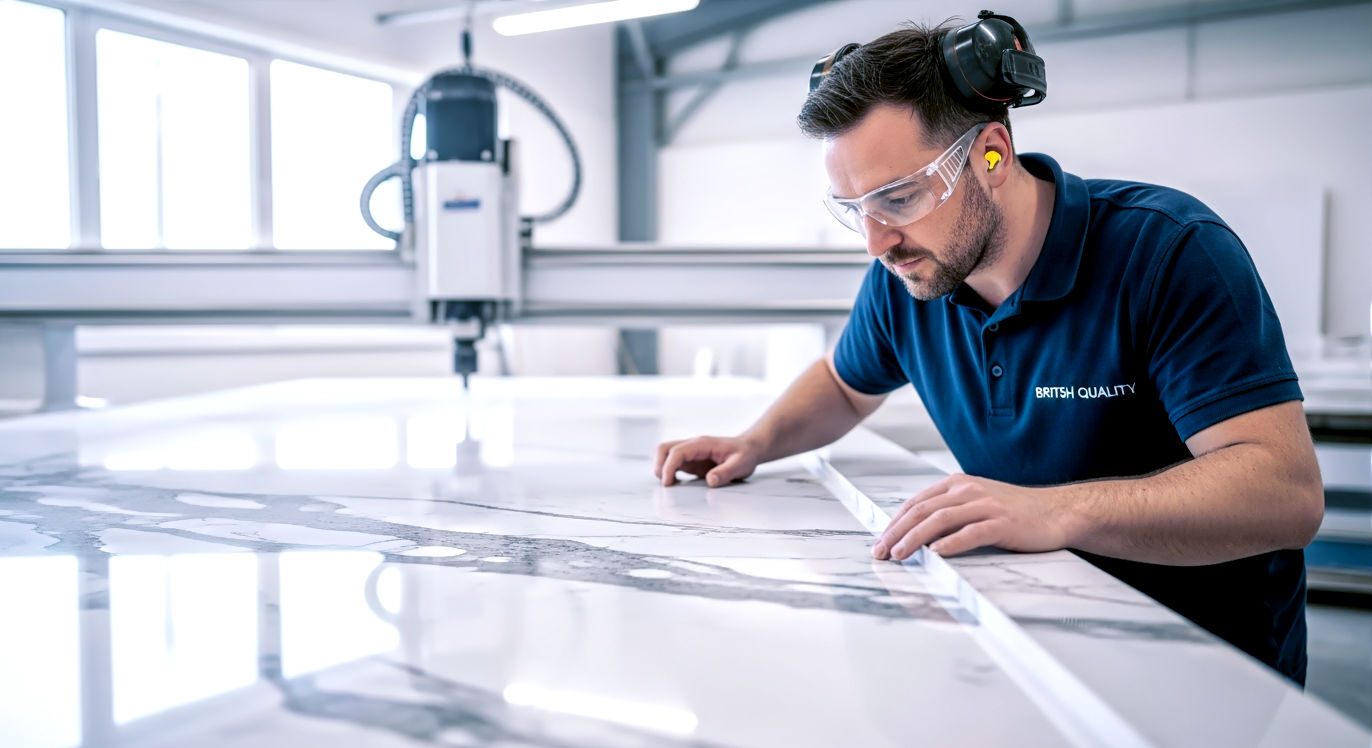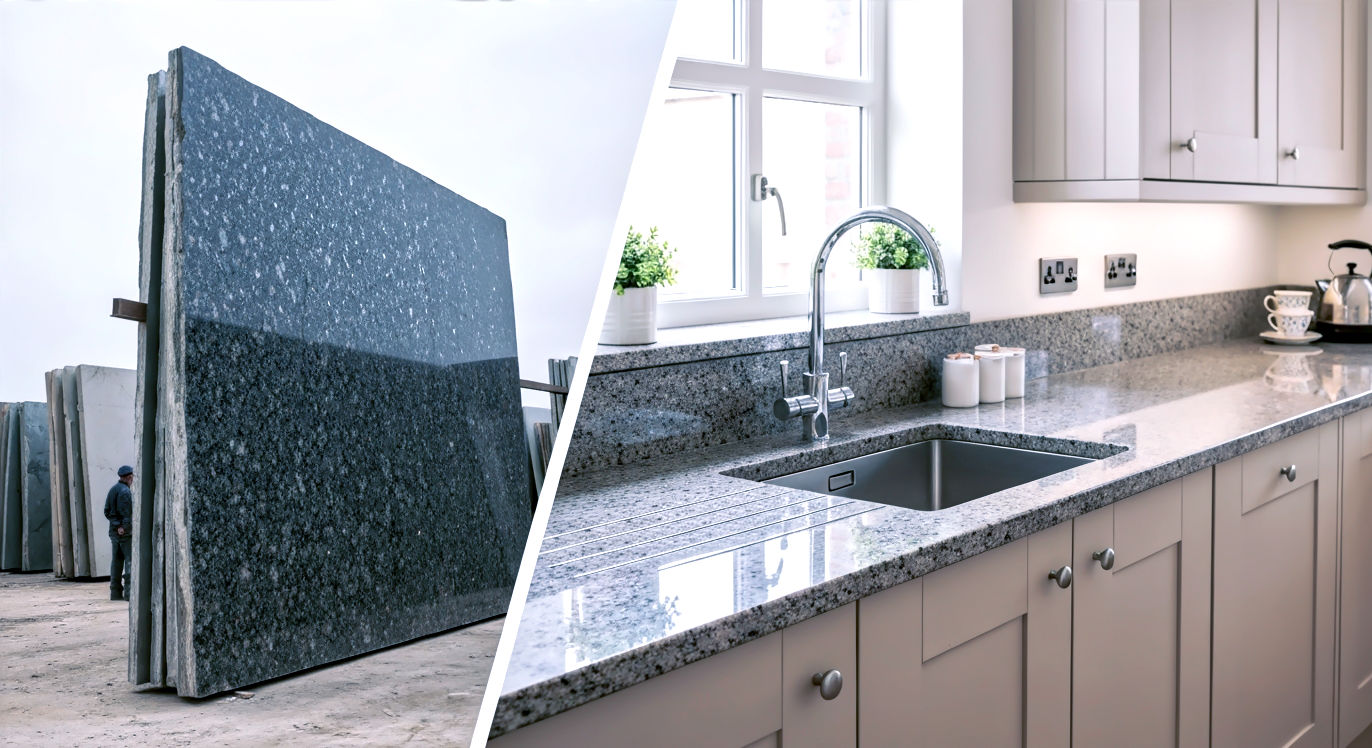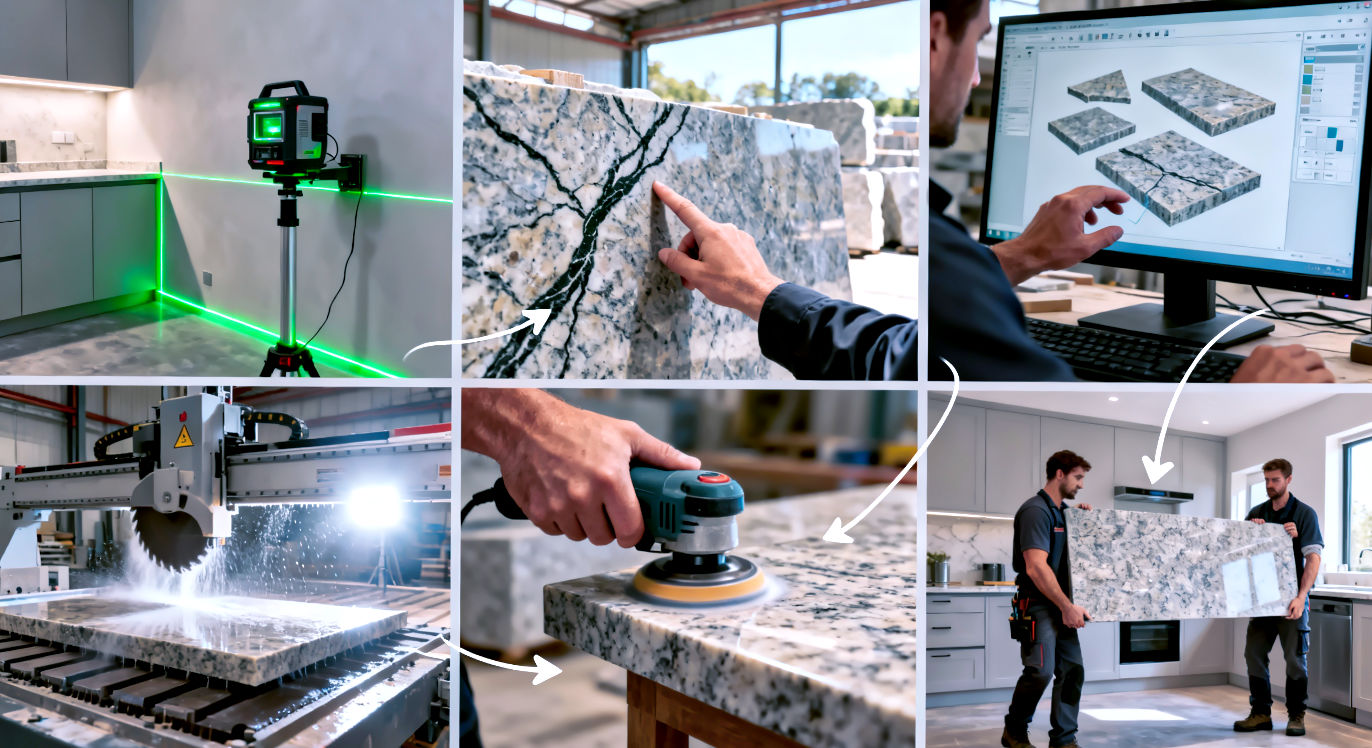The Guide to Kitchen Worktop Fabricators: What They Do & How to Choose the Best
Your dream kitchen needs a worktop fabricator. This guide explains what they do (from templating to fitting) and how to choose the best craftsman.

This post may contain affiliate links. If you make a purchase through these links, we may earn a commission at no additional cost to you.
The kitchen isn’t just a room; it’s the heart of the modern British home. It’s where we make our morning brew, wrangle with the kids over homework, gossip over a glass of wine, and pull off a magnificent Sunday roast. And the stage for all this daily drama? The humble kitchen worktop.
When you decide to upgrade this all-important surface, you dive into a world of beautiful materials. You’ve held samples of gleaming quartz, stroked the cool, speckled surface of granite, and admired the sleek new porcelains. You’ve picked a winner.
But then you hit a snag. You can’t just go to a shop, buy a 3-metre slab of “Calacatta Gold” quartz, and pop it in your boot.
So, who actually turns that giant, raw slab of stone into the perfectly fitted centrepiece of your kitchen, complete with a hole for your sink and a flawless finish?
Meet the kitchen worktop fabricator.
This article is your definitive guide to these unsung heroes of the kitchen industry. We’ll pull back the curtain on exactly what they do (it’s more science and art than you’d think) and give you a rock-solid 10-point checklist on how to choose the best one for your project.
Think of a fabricator as a bespoke tailor for your kitchen. You wouldn’t buy a roll of Savile Row cloth and hope for the best; you’d hire a master tailor to measure, cut, and craft it into a suit that fits you perfectly. A fabricator does the same, but with a 300kg slab of stone and a set of tools that look like they belong in a high-tech lab.
What is a Kitchen Worktop Fabricator? (And Why You Can’t Just Buy a Slab)
First, let’s clear up some confusion. The journey of your worktop involves a few different players, and it’s easy to get them muddled.

The Myth of “Buying a Worktop”
In most cases, you don’t just “buy a worktop” off the shelf. You buy a complete fabrication and installation service. The stone itself might only be 50-60% of the final bill. The rest is for the skill, labour, and technology to make it fit your home.
Let’s break down the cast:
- The Supplier / Retailer: This could be a big DIY shed (like B&Q or Homebase), your kitchen company (like Howdens or Wren), or a “stone yard.” They are the shop front. They sell you the idea of the worktop and, in many cases, the raw material.
- The Fabricator: This is the workshop, the factory, the “skunk works.” They are the artisan company that has the million-pound machinery (saws, CNC machines, waterjets) and the skilled craftsmen who physically transform the slab.
- The Fitter / Installer: This is the person who comes to your house to install the finished pieces.
Here’s the key: A great fabricator is almost always the installer, too. They control the entire process, from measuring your kitchen to fitting the final piece. This “full-service” model is what you should be looking for.
A Fabricator is a Craftsman, Not Just a Fitter
Why not just let your kitchen company sort it out? You can, but they will almost certainly just sub-contract the job to a local fabricator. The problem? They’ll often choose the cheapest one, not the best one. You’re now a middle-man in your own project, and you have no relationship with the actual craftsmen doing the work.
By going directly to a fabricator, you are hiring a specialist. This is their entire business. They live and breathe stone.
Think of it this way:
- A kitchen fitter is brilliant at levelling cabinets and hanging doors.
- A fabricator is a specialist stonemason who knows how to cut a 20mm slab of quartz so precisely that the join (or “seam”) is almost invisible.
These are not the same skills. The modern fabricator is a high-tech evolution of the traditional British stonemason, a trade that built our cathedrals and lined our cities with Welsh slate and Aberdeen granite. They blend that age-old respect for the material with cutting-edge technology.
The Fabrication Journey: From Raw Slab to Perfect Surface (The 7-Step Process)
So, what do these “master tailors” actually do? Let’s walk through the entire journey, from your first cup of tea in their showroom to the final polish in your kitchen.

Step 1: The Consultation & Quoting
It starts with a visit. You’ll go to the fabricator’s showroom, armed with a rough sketch of your kitchen layout (your “plan”) and some approximate measurements.
This is where you’ll discuss:
- Your lifestyle: Do you have kids? Are you a messy cook? Do you bake (which needs a cool surface like marble)?
- Your style: Are you after a modern, sleek look (handleless, thin profile) or a classic farmhouse kitchen (shaker units, chunky edges)?
- Material: They’ll walk you through the pros and cons of Quartz (man-made, tough, consistent), Granite (natural, unique, needs sealing), Marble (beautiful, porous, high-maintenance), and newer materials like Porcelain or Sintered Stone (super tough, thin, tricky to work with).
They will then give you an initial estimate. This is just a ballpark figure based on your rough sizes. The real price comes after the next, most important step.
Step 2: Templating (The Most Important Step)
Once your new kitchen units are fully installed, fixed to the wall, and perfectly level, the fabricator sends a technician to template. This is the master measurement.
This is the single most critical stage of the whole process. Why? Because in the real world, no wall is perfectly straight and no corner is a perfect 90 degrees. This is especially true in the charming, wonky Victorian and Edwardian homes many of us live in.
There are two ways to do this:
Traditional Templating (The Old-School Way)
- How it works: The technician builds a “skeleton” of your worktops on-site using strips of wood or, more commonly, plastic Correx sheets. They cut and glue these strips together to create an exact physical pattern of your kitchen.
- Pros: It’s a tried-and-tested method that skilled craftsmen have used for decades.
- Cons: It’s slower, and you’ll likely need to have your sink and hob disconnected. The physical template can warp or be damaged.
Digital Templating (The High-Tech Way)
- How it works: A technician uses a sophisticated laser templating device. This machine sits on a tripod and fires a laser beam, or uses a “digital pen” on an articulated arm, to map every single nook, cranny, and bow in your wall to sub-millimetre accuracy.
- Pros: It’s unbelievably precise, fast, and clean. It can often be done with your old worktops still in place. The result is a perfect 3D digital file (a .DXF file) that can be sent straight to the cutting machines.
- Cons: The equipment costs a fortune, so only serious, established fabricators invest in it.
Your Critical Job: Before the templater arrives, your units must be 100% finished, level, and fixed in their final position. Your new sink, tap, and hob must be on-site (not in the box!) so the templater can take their exact measurements.
Step 3: Material Sourcing & Slab Selection
With your digital template in hand, the fabricator now orders your material.
If you’ve chosen an engineered stone like quartz (from brands like Silestone, Caesarstone, or Compac), it’s simple. They order the slabs from the brand’s UK distributor. They will ensure all slabs come from the same “batch” to guarantee the colour and pattern are a perfect match.
If you’ve chosen a natural stone like granite or marble, you get to do something special: the slab viewing.
- The fabricator will send you to their stone supplier’s “slab yard” (a giant warehouse full of stone).
- You walk the aisles and physically choose your exact slabs.
- This is vital because every slab of natural stone is unique—a piece of geological art. You can pick one with a dramatic “river” of quartz running through it, or a quieter, more speckled piece. You also get to check for natural flaws, like pits or fissures, that you might want to avoid.
Step 4: The Digital Layout (Where Art Meets Science)
This is where the real artistry happens, and it’s something most customers never see.
Back at the workshop, the fabricator loads your digital template file onto a computer. They then take a high-resolution photo of your chosen slab and load that in, too.
On the screen, they digitally “lay out” the pieces of your worktop onto the slab. This allows them to:
- Vein Match: Plan the cuts so the natural vein in the stone flows beautifully around a corner or across a seam.
- Book Match: If you have two adjoining pieces (like on an island), they can cut them from the slab so they open up like a book, creating a stunning mirror image.
- Avoid Flaws: They can position your sink cut-out right over a natural pit or blemish you didn’t like.
- Minimise Waste: They can “nest” the pieces together to get the most out of one expensive slab, saving you money.
A lazy fabricator just cuts. A great fabricator composes.
Step 5: Fabrication (The Noisy Part)
Now, the digital file is sent to the workshop floor. This is where the magic (and the noise) begins.

- Primary Cutting: The slab is loaded onto a massive cutting machine.
- Bridge Saw: A traditional diamond-blade saw that cuts in straight lines.
- CNC / Waterjet: The high-tech option. A CNC (Computer Numerical Control) machine is a giant, automated robot with multiple tools that can cut, drill, and profile the stone based on the digital file. A Waterjet uses a pencil-thin jet of water mixed with abrasive grit, fired at 60,000 PSI, to cut any shape flawlessly with no stress on the stone.
- Edge Profiling: The machines (or sometimes a craftsman by hand) cut your chosen edge profile. This is the “shape” of the worktop’s front edge. Popular UK choices include:
- Pencil: A simple, modern edge with slightly rounded top and bottom corners.
- Half Bullnose: A curved top edge and a flat bottom. Great at stopping spills from dripping onto your cabinet doors.
- Ogee / Dupont: A classic, decorative “S” shape. Perfect for traditional or shaker-style kitchens.
- Mitred Edge: A very clever trick. The fabricator cuts a 45-degree angle on the worktop edge and on a separate “downstand” strip. When joined, they create a seamless edge that can make a standard 20mm top look like a chunky 40mm or 50mm block. This is the hallmark of a high-skill fabricator.
- Cut-Outs & Drainers: The holes for your sink and hob are precisely cut. For an undermount sink, the inside edge of the cut-out is then painstakingly polished to a perfect shine—a key sign of quality. They will also mill any drainer grooves you’ve requested.
Step 6: Quality Control, Finishing & Sealing
The cut pieces are moved to a finishing area. A craftsman will inspect every edge, hand-finishing and polishing any areas the machines can’t reach. The whole surface is cleaned and inspected for any flaws.
If it’s natural stone (granite or marble), this is when they apply a professional-grade impregnating sealer. This liquid soaks into the stone’s microscopic pores (stone is like a hard sponge) and blocks them, which stops things like red wine, lemon juice, or curry from staining it.
Engineered quartz and porcelain do not need sealing. They are non-porous from the start.
Step 7: The Installation (The Final Hurdle)
The big day. The fitting team (usually two or three strong, very strong, people) arrives with your new worktops.
- Dry Fit: They’ll carefully carry each piece in and lay it on your cabinets for a “dry fit” to make sure everything is perfect.
- Levelling: They use shims (tiny plastic wedges) to get every piece perfectly level.
- Fixing: The worktops are fixed to the cabinets using dollops of silicone. This holds them firm but allows for tiny seasonal movements in your house.
- The Seam: This is the final test of a fabricator’s skill. To join two pieces, they:
- Apply a special, colour-matched epoxy resin to the edges.
- Use heavy-duty “seam-setting” clamps to pull the two pieces together with immense pressure.
- The resin is forced up, and once cured, it’s scraped and polished flat.
A good seam should be a thin, clean line that you can barely feel with your fingernail. It should not be a gappy, silicone-filled trench.
Finally, they’ll fit any upstands or splashbacks, seal the join between the worktop and the wall, and give the whole surface a final clean.
How to Choose the Best Kitchen Worktop Fabricator: A 10-Point Checklist
You’re now an expert on the “what.” But how do you find a good ‘un? It’s not just about price. A cheap job that leaves you with a wobbly, badly-joined worktop is a very expensive mistake.
Here is your 10-point checklist for finding a true craftsman.
1. Visit Their Showroom & Workshop
A professional fabricator will have a proper showroom. This shows they are established and proud of their work. But don’t stop there.
Ask for a tour of their workshop. This is the real test.
- Is it a tidy, organised, professional space?
- Can you see the big machinery? A bridge saw? A CNC machine?
- Or is it just a dusty lock-up with a ‘man in a van’ cutting slabs in the car park? (Run away if it’s the latter—silica dust is a major health hazard).
2. Read the Reviews (And Read Between the Lines)
Check them out on Google, Trustpilot, and Checkatrade. Don’t just look at the 5-star ratings. Read what people are actually saying.
- Green Flags: “The templating was so precise,” “The fitters were amazing,” “My seam is invisible,” “They were so patient and helpful,” “They sorted a small problem immediately.”
- Red Flags: “The measurements were wrong,” “The seam is gappy and a different colour,” “They damaged my new cabinets,” “They left a huge mess,” “I can’t get them to come back.”
3. Verify Their Accreditations
This is your quality assurance. The UK has trade bodies for the stone industry.
- The Stone Federation Great Britain (SFGB): This is the big one. Members are vetted, must have the correct insurance, and adhere to strict British Standards and codes of practice.
- Brand-Specific Approvals: Are they an “Approved Silestone Fabricator” or “Caesarstone Certified”? This means the material brand itself trusts them to work with their product (and will honour the warranty).

4. Ask to See Their “Slab Yard” (Or Their Supplier’s)
Even if you’re buying quartz, ask where they get their stone. A good fabricator will have a “boneyard” of off-cuts from other jobs, which is great for small projects like a vanity top. For big jobs, they’ll have a strong relationship with the big UK stone suppliers and will happily arrange for you to visit and pick your own slab.
5. Discuss Templating: Digital or Manual?
Ask them: “Do you do digital or manual templating?”
As we learned, a firm that has invested in a digital laser templater is serious about precision. It’s a very good sign. If they use manual Correx templates, that’s not a deal-breaker, but ask them how they handle wonky walls. A good answer is: “We scribe every piece perfectly to the wall.”
6. Get a Detailed, Itemised Quote
A one-line quote is a red flag. A professional quote should break everything down so there are no nasty surprises. It must include:
- Material name, brand, and thickness (e.g., “Silestone Calacatta Gold, 20mm”).
- Cost for templating, fabrication, and installation.
- Cost for all cut-outs (sink, hob, pop-up sockets).
- Cost for your chosen edge profile (fancy edges often cost more).
- Cost for upstands, splashbacks, or windowsills.
- Waste disposal (are they taking your old tops?).
- VAT. (Always, always check if VAT is included).
7. Ask About Seams
This question will immediately tell you if you’re dealing with a pro. Ask them: “Based on my plan, how many seams will I have, and where will you put them?”
A pro will get out your drawing and explain why. “We’ll put one here, over the dishwasher, so it’s a small, supported piece. We’ll avoid putting one near the hob. We’ll make sure the vein flows across the join.” An amateur will just say, “Dunno, the fitters will sort it.”
8. Check Their Insurance (The Boring But Vital Bit)
Ask them: “Can I see a copy of your Public Liability Insurance certificate?”
A reputable firm will email it to you without blinking. This insurance covers your property. If they drop a 300kg slab of granite and smash your new tiled floor or crack your new oven, this is what pays for it. If they don’t have it, don’t let them in your house.
9. Understand Their Guarantees & Warranties
You get two types of protection:
- The Material Warranty: This comes from the brand (e.g., Silestone offers a 25-year warranty on their quartz).
- The Workmanship Guarantee: This comes from the fabricator. It covers their work: the installation, the seams, the fitting. Ask them what it is and get it in writing. One year is a standard minimum.
10. Go With Your Gut (The “Cup of Tea” Test)
Finally, use the classic British test. Do you like them? Are they polite, patient, and happy to answer your (now very intelligent) questions? Do they respond to emails?
This is a company you are trusting to come into your home for two of the most critical days of your renovation (templating and fitting). If they seem dodgy, disorganised, or pushy, walk away. Go with the people you’d be happy to make a cup of tea for.
Common Pitfalls (And How to Dodge Them)
- Pitfall 1: The “Too Good to Be True” Price. A “man with a van” on Facebook offering granite for half the price. They are likely using cheap, unvetted imported stone, have no insurance, and will “template” with a tape measure. They’ll probably cut it in your garden, covering your patio in toxic silica dust. Avoid.
- Pitfall 2: The Kitchen Showroom “Package Deal.” As mentioned, your kitchen company is just a middle-man. You pay them, they pay a fabricator you’ve never met. Go direct. It’s often cheaper, and you get a far better service.
- Pitfall 3: Not Preparing Your Site. If your units aren’t level when the templater arrives, they’ll have to charge you for a wasted visit. If they aren’t level for the fitters, your worktop will rock, and the seam will crack. It’s your responsibility to have the canvas ready.
- Pitfall 4: Rushing the Templating. Forgetting to have your new sink on-site is a classic. The templater can’t guess its size. This will delay your whole project.
The Future of Fabrication: What’s Next?
The industry is moving fast. The best fabricators are now investing in:
- Sustainability: Water in the workshops is recycled (stone is cut “wet” to control dust). They are finding ways to recycle and re-use off-cuts.
- New Materials: Ultra-compact surfaces (like Dekton and Neolith) and porcelains are the new “it” materials. They are incredibly tough, heat-proof, and stain-proof, but they are very difficult and brittle to cut. Only the absolute best fabricators with the latest waterjet machines can handle them. This is separating the pros from the amateurs.
- Automation: More robotic arms and CNC machines mean even greater precision, especially for complex, curved designs.
Conclusion: Your Kitchen’s Master Tailor
A worktop fabricator is one of the most skilled and technologically advanced trades you’ll have in your home. They are not just “fitters”—they are precision engineers, digital craftsmen, and artists in stone.
They are the difference between a worktop that simply fits and a worktop that truly finishes your kitchen.
Choosing one isn’t just about the price per metre. It’s about trusting their expertise, their technology, and their skill. Use the checklist, ask the right questions, and find a fabricator you trust. You’ll be rewarded every single day when you walk into your kitchen and run your hand over a perfect, seamless, and beautifully crafted surface.
Further Reading
For more information, advice, and to find accredited members, check out these excellent UK resources:
- Stone Federation Great Britain: The official trade association for the UK stone industry. A great place to find vetted and accredited members.
- Silestone UK: A leading quartz brand. Their website has great inspiration and details on how to find their approved fabricators.
- Ideal Home: A fantastic resource for all things British kitchen design, including material guides and inspiration.




